Striking images of black struggle
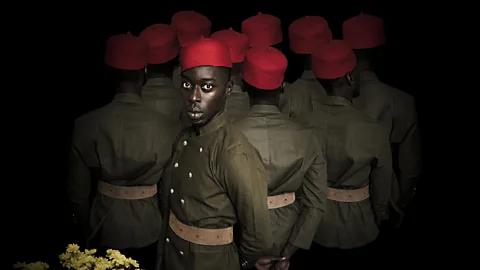 Omar Victor Diop / MAGNIN-A
Omar Victor Diop / MAGNIN-AThe photographer Omar Victor Diop re-enacts defining moments of black struggle in Africa and its diaspora for his latest project.
Liberty: A Universal Chronology of Black was conceived and created in Dakar, Senegal, the city where Omar Victor Diop was born and lives today.
The project visualises some of the most decisive and lesser-known moments of a global struggle: from the Maroon resistance in 18th-Century Jamaica to the killing of Trayvon Martin in 2012, which inspired the Black Lives Matter movement.
Diop puts himself in the shoes of Senegalese World War Two soldiers, South African students and the Black Panther Party to explore what unifies and defines these struggles for human rights and freedom.
“The Liberty project is a journey that I started last year, in which I recount, interpret and juxtapose some of the defining moments of black history” Diop tells BBC Culture. His project both pays homage to relevant individuals and stresses the importance of the collective in the struggle for human rights. “I felt it was needed on both a personal and global level,” he explains. “Many of the injustices that the sons and daughters of Africa fought against, across the world, are still very much alive.”
Despite the dramatic nature of the episodes he reimagines, the tone of Diop’s project is not one of condolence, but of celebration and pride. The result is a series of powerful images that mix the sombre with the colourful, paying homage to the fallen and offering hope for the future.
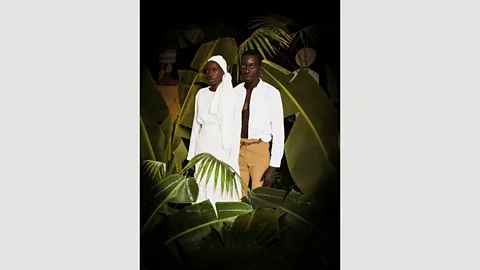 Omar Victor Diop / MAGNIN-A
Omar Victor Diop / MAGNIN-ABorn into the Asante people (now Ghana) and taken to a plantation in Jamaica, Queen Nanny (c 1686-c 1755) is believed to have escaped slavery with her brother Quao. In 1720 they founded the Maroon community in the town of Portland. The area was named Nanny Town and was home to escaped slaves who felt protected from the British rulers thanks to the difficulty accessing this hilly area. Nanny and her brother are believed to have helped liberate hundreds of slaves over the course of 30 years. In this portrait Diop, as Quao, stands strong by his sister, surrounded by plants.
Diop first explored portraiture with projects such as The Studio of Vanities, in which he portrayed a generation of young African entrepreneurs while paying homage to the West African studio photography masters like Seydou Keita and Mama Casset. After establishing himself as one of their successors, Diop first put himself in front of the camera for Project Diaspora, a series of self-portraits based on honorific historical paintings of notable Africans outside of the continent. “Liberty is a follow up to Diaspora,” Diop explains. “I used the same self-portrait technique as Diaspora, the only difference being that in this series, I highlight the spearheading role of black women, interpreted by my female alter-ego, Dija Boye”.
 Omar Victor Diop / MAGNIN-A
Omar Victor Diop / MAGNIN-AIn The Women’s War, Boye is not only Diop’s alter ego. She also embodies the more than 25,000 women who in 1929 rebelled against policies imposed by British authorities in southeast Nigeria, including taxes on female market traders. These taxes were collected by male warrant chiefs appointed by the colonial governors. The Women’s War, also known as the Aba Women’s Riots, was fought to preserve the status women had in their societies before the colonies. The matriarchal system was seen as a threat and against the moral order by the colonial power. After months of unrest the British rulers had to agree to reforms. These women’s activism is considered a first challenge to British colonial power in Nigeria and West Africa and has become a historic example of feminist protest.
 Omar Victor Diop / MAGNIN-A
Omar Victor Diop / MAGNIN-AIn March 1965, three marches took place along the highway linking Selma to the state capital of Montgomery in Alabama. Protesters were demanding African Americans' right to vote in the US. Many of the 600 protesters were attacked by law enforcement agencies, state troopers and white separatists. Dr Martin Luther King ed the marches, which brought international attention to the civil rights struggle, culminating in the g of the Voting Rights Act of 1965.
In Diop’s detailed recreations, clothing and style are central to convey political messages, but also historical accuracy. Some marchers wore white Hawaiian garlands which had been sent to Dr Martin Luther King by Reverend Abraham Akaka as a gesture of Asian-American solidarity. The optimism of the flowers contrast with the violence the protesters endured.
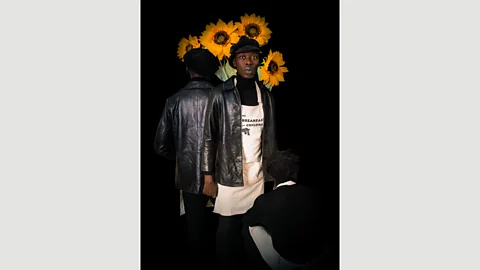 Omar Victor Diop / MAGNIN-A
Omar Victor Diop / MAGNIN-AIn this image, Diop wears an apron in recognition of the revolutionary community programme created by the Black Panthers in Oakland, California. Acknowledging that children could not perform in school if they were hungry, the programme provided free breakfast to disadvantaged children. It was funded by donations from the communities, local shops, churches and groceries. It extended all over the country, feeding more than 20,000 school children.
Diop investigates historic images, finding inspiration to create self-fashioned portraits that highlight different stories and identities. “Liberty nods at sartorial traditions from various black communities living across the world,” Diop explains.
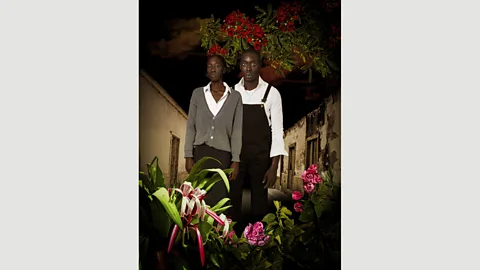 Omar Victor Diop / MAGNIN-A
Omar Victor Diop / MAGNIN-AOn the morning of 16 June 1976, around 20,000 students from Soweto schools marched together to protest against the introduction of Afrikaans as the primary language of instruction. Police opened fire on the students, killing hundreds of young boys and girls. The Soweto Uprising became a key date in the fight against apartheid, inspiring the second wave of protests that ended apartheid in the 1980s. Diop stands affirming the important role of young people in protest movements.
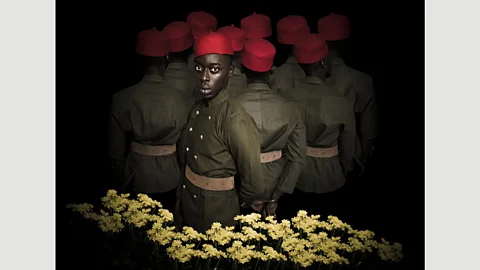 Omar Victor Diop / MAGNIN-A
Omar Victor Diop / MAGNIN-AThe Senegalese Tirailleurs were West African soldiers fighting for the French army during World War Two. After the liberation of , the surviving soldiers were repatriated and promised remuneration and pensions for their service.
On 1 December 1944, a group of soldiers staged protest in Dakar’s Thiaroye camp, demanding better working conditions in return for their services. The response was a harsh repression in which 70 veterans were killed. Diop appears before the soldiers whose revolt was crucial for the creation of a nationalist movement against French colonial rule.
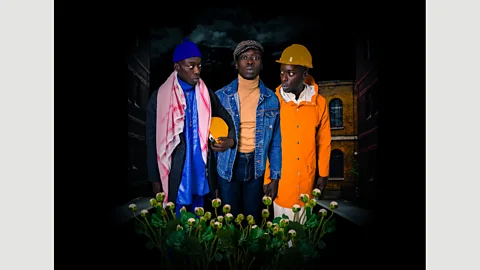 Omar Victor Diop / MAGNIN-A, Paris
Omar Victor Diop / MAGNIN-A, ParisFrom 1974 to 1980, a prolonged strike pitted the tenants of Sonacotra, a French state-owned agency responsible for providing public housing to migrant workers from north and sub-Saharan Africa, against its management, many of whom were former colonial officers. Those striking opposed perpetual rent increases and demanded better living conditions, paving the way for the first collective protest of black African immigrants in postcolonial . A struggle for tenants’ and workers’ rights, the Sonacotra Tenant Strike is regarded as a pivotal moment of black solidarity in the history of collective political activism by African diasporas in Europe. Diop takes on three different personas with a variety of symbolic clothing from North and sub-Saharan Africa to depict this crucial moment.
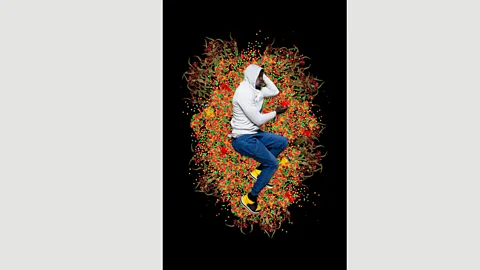 Omar Victor Diop / MAGNIN-A
Omar Victor Diop / MAGNIN-AOn the way back to his father’s house in Sanford, Florida, carrying iced tea and a bag of Skittles, 17 year-old Trayvon Martin crossed a fenced area where a series of burglaries had taken place. Neighbourhood watch volunteer George Zimmerman shot him dead and was acquitted following a trial. The incident prompted a series of protests against systemic racism and police violence against of the African-American community, helping to give rise to the Black Lives Matter movement. In March 2012 thousands of people marched together in New York wearing hoodies and holding bags of Skittles. The colourful sweets around Diop in this photograph create a halo around the boy's body, lending it a religious tone. It's a resonance to be found in several of Diop's saint-like portraits of these collective freedom fighters.
Liberty / Diaspora by Omar Victor Diop is at Autograph, London from 20 July – 3 November 2018.
If you would like to comment on this story or anything else you have seen on BBC Culture, head over to our Facebook page or message us on Twitter.
And if you liked this story, sign up for the weekly bbc.com features newsletter, called “If You Only Read 6 Things This Week”. A handpicked selection of stories from BBC Future, Earth, Culture, Capital and Travel, delivered to your inbox every Friday.
